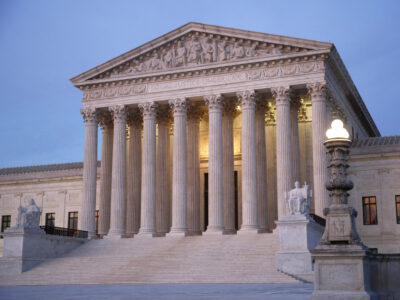Will the Supreme Court Gut the Clean Water Act?
We’re about to find out in an upcoming case.
What wetlands and waterbodies does the Clean Water Act protect? Congress failed to provide a clear answer when it passed the statute, and the issue has been a bone of contention ever since. The Biden Administration is in the process of issuing a new regulation on the subject. Normally, you’d expect the Supreme Court to wait to jump in until then. Instead, the Court reached out to grab Sackett v. EPA, where landowners take a really extreme position on the subject. Not a good sign.
A little quick background: The term “navigable waters” traditionally meant water bodies that could be used for transportation. When it passed the Clean Water Act, Congress redefined the term to mean “waters of the United States.” Everyone agrees that this term covers at least traditional navigable waters and wetlands on their shores. But what else is covered? The Supreme Court has issued several rather confusing issues on the subject. The lower courts read the Court’s decisions to include wetlands and tributaries that have a “significant nexus” with traditional navigable waters. In one of those decisions, Justice Scalia and three other conservatives favored a much narrower definition, which was more or less tracked in later Trump Administration regulation.
The landowners in Sackett take a position that would restrict federal jurisdiction even more than Scalia or Trump. In their brief, they argue for a two-step test:
-
- “Step one: is the wetland inseparably bound up with a “water”—i.e., a stream, ocean, river, lake, or similar hydrogeographic feature that in ordinary parlance would be called a “water”—by means of a continuous surface-water connection, such that it is difficult to tell where the wetland ends and the “water” begins?
- “Step two: is the ‘water’ among ‘the waters of the United States,’ i.e., those waterbodies subject to Congress’s authority over the channels of interstate commerce?”
As the government’s brief points out, under this test a wetland would lose federal protection if someone builds a road or levee across it, or even if a flood leaves a natural berm of soil between the two. Any of those events would eliminate the “continuous surface-water connection.” Moreover, the government points out, this test would eliminate federal jurisdiction over non-navigable tributaries of navigable streams. This makes no sense: the Clean Water Act’s goal is to prevent pollution, not barriers to navigation.
One thing to watch for: will the Court apply the major questions doctrine, as it did in West Virginia v. EPA? If the Court gives a narrow reading to the West Virginia case, it shouldn’t apply the doctrine. Unlike the climate change regulation involved in West Virginia v. EPA, federal jurisdiction over wetlands involves a central provision of the statute and does not involve an unprecedented claim of regulatory authority by the agency. The agency has claimed regulatory authority going beyond the Scalia approach since before the Bush Administration. If the Court nonetheless relies on the major question doctrine, it will be expanding the doctrine beyond the West Virginia ruling.
Given the ways in which the landowners’ approach goes beyond Scalia and Trump, it may go too far even for this highly conservative group of judges. Still, I wouldn’t want to put a lot of money on that bet.
Reader Comments
4 Replies to “Will the Supreme Court Gut the Clean Water Act?”
Comments are closed.








Filling a jurisdictional wetland with soil or debris without a 404 permit is actionable under the CWA citizen suit provision, so long as the statutory violation is ongoing at time of suit. In the close-ish cases, at least on the Texas Gulf Coast, the developer will proceed as though no 404 permit is needed. A diligent developer can eliminate a lot of continuous surface-water connections in 60 days.
I would argue that Congress never intended to extend federal jurisdiction to intermittent streams that do not have a permanent connection to navigable water. So the only “gutting” would be the arbitrary and capricious expansion of federal jurisdiction.
See fn 8 of Bayview Riverside from around 1984 or so.
Congress -not some GM-15 – has not changed the definition of a nav water in almost a century. And then all they did was add “or could be reasonably made so”
Finally for I dunno? a thousand years? the common law definition of a nav water’s Ordinary High Water Mark had a “from” in it. A mark made by a rising ocean or a rising tide. In 1986 the Corps by GM-15 fiat took out the “from.”
Moi? I hope SCOTUS pounds the Corps so far below grade they’ll need a stepladder to see daylight.
One world
One Nation